The use of plant growth regulation is taken for granted in some crops and regarded as standard husbandry in crops such as wheat and oats. Barley is more uncertain and, more often than not, growth regulation is not used. A session at the BASF conference earlier this year focused on growth regulation and it is useful to go back to the first principles of keeping crops standing.
Firstly, some level of plant growth regulation (PGR) is essential in oats and six-row winter barley varieties as lodging is inevitable if it is not used in commercial crops.
But the same may not be true of winter wheat where plant breeders have improved straw strength and standing power considerably in recent decades. That said, most growers would feel uncomfortable and a bit naked if they did not have growth regulation on wheat.
The situation is less certain with barley. It has often been said by people such as John Spink of Teagasc and Donal Fitzgerald of Goldcrop that we now have winter barley yield levels on spring barley straw and that it can be a big ask to hold up that level of yield. The challenge has been to get PGR programmes that perform consistently well in the vagaries of the Irish climate.

Straw strength can be a big issue in barley, depending on the growing season, because we require significant stem density to optimise yield.
Types of lodging
Before talking about the specific challenges associated with PGRs it is important to consider the principles behind the regulation of plant growth and how lodging comes about.
At the BASF conference, Dudley Kitching from BASF spoke about two major forms of lodging:
Root roll, which can be very damaging to yieldLack of adequate stem strength, which can be halved during grain fill due to the weight of the head. The risk from these two lodging sources varies with the crop. The stronger the stem the greater the pressure on root anchorage and so the greater the risk from this source.
Let me add a bit of perspective. For me, lodging is when the stem kinks, between the first and second or second and third nodes. This kink will generally enable the full stem to drop to the ground and the canopy sits on itself, which facilitates disease spread and significantly reduces the efficiency of photosynthesis and the upwards and downwards movement of essential plant metabolites.
Root roll occurs when the ground gets very wet, indeed saturated, and the roots lose their grip in the liquid mass allowing the stem to roll and fall over. This will most likely happen when the weight of the head is high during grain fill and root roll tends to occur in large patches leaving the crop totally flat on the ground. Risk is greatest when the canopy itself holds a lot of water and this, plus head weight and saturated soil, forces the plant to lean and the lateral roots to pull through the soil. While the stem may not be kinked, this form of lodging can be very widespread in a crop and severely hamper its ability to secure good grain fill and yield.
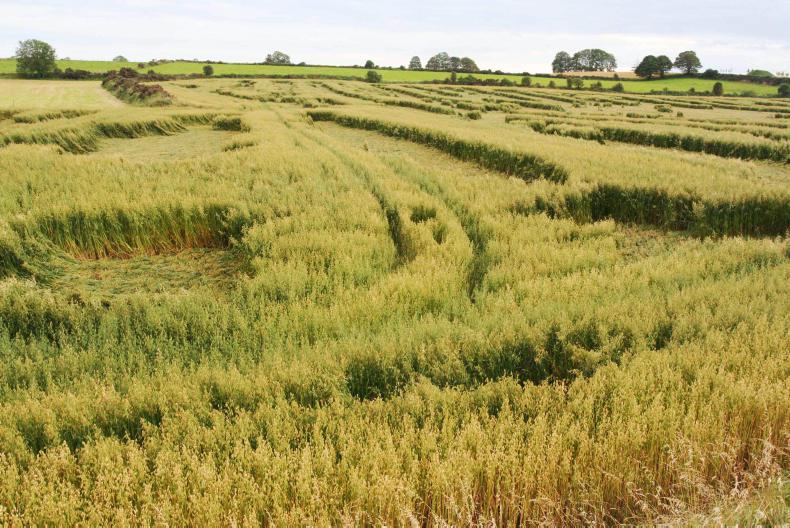
A strong stem base, plus shortening of the straw are both important to help prevent lodging in oats, but so is uniform nitrogen application.
A further straw issue might be described as maturity lodging, straw breakdown or brackling. These are largely the same thing and they are not so much a breaking of the stem as a weakening of a node on the stem.
When this happens, the straw above the node lies over to give the crop a broken-down appearance. Brackling is a separate issue and may or may not be related to straw strength but it does appear to be a variety factor and is influenced by fertiliser and fungicide use.
Factors that affect straw
The most controllable lodging risk factor for any crops is the inherent strength of the variety. This differs between individual varieties of a species and indeed between species also. This is genetics.
Lodging risk is often associated with straw length but this is not always a strongly linked characteristic. Straw length is poorly linked to lodging in wheat but longer straw in barley or oats can be a different matter. But short straw is not necessarily a measure of straw strength either.
Lodging prevention is a combination of many factors that can impact in different or additive ways to increase or decrease pressure on standing power. In order of occurrance these include:
Variety strength.Sowing date.Seeding rate – more seed means more pressure.The seedbed – rolling helps against root roll.The amount of early nitrogen applied.The total amount of N up to stem extension. Application of a PGR.While these are not equally applicable to all crops it is important to be aware of them. All these should be considered to minimise lodging pressure and to reduce the dependence on PGR because there is no guarantee that a spray can ever counteract high lodging pressure.
It is also important to be aware that weather pattern can have an effect. Increasing day length is an important trigger in the move from vegetative growth to stem extension and reproductive growth. If growth is slowed by cold conditions during early stem extension, it is not uncommon that such crops would exhibit a burst of stem extension when conditions improve. This short burst of rapid growth can leave stems considerably weaker than normal so it is important to be able to pre-empt such risks.
Types of growth regulator
There are two main groups of growth regulating agents for cereals – gibberellic acid inhibitors and ethylene generators. When plants move into stem extension, a natural plant hormone called gibberellin or gibberellic acid alters growth to drive elongation and extension and this process continues to eventually push the developing ear out at the top of the stem.
Being able to slow this extension or reduce elongation has the effect of shortening the plant and possibly also increasing the strength of the stem to reduce lodging risk. This is possible by using gibberellic acid inhibitors and the compounds that act in this way include chlormequat (CCC), mepiquat (contained in Terpal and Canopy), trinexapac (Modus) and prohexadione (contained in Canopy and Medax Max).
The ethylene generating products are ethephon-based, containing 2-chloroethylphosphonic acid and contained in products such as Terpal and Cerone. These were traditionally applied later in the season, up to the point of booting, to shorten the stem but might be of limited use where the growth pattern of the crop had already weakened the base of the stem.
The approach to growth regulation should be influenced by the specific crop, the sowing date and the weather. Different individual actives are influenced to a greater or lesser degree by temperature and it has often been stated in the past that CCC has difficulty getting into the plant tissue in cold weather.
It is also important to remember that growth regulators will do more growth regulation when there is active growth following treatment. For many actives, no growth means less shortening or strengthening.
Targeting a more versatile PGR
Against this background, Dudley Kitching stated that his company’s Medax Max is particularly suited to both short and longer-term growth regulation in the crop. Its two active ingredients, prohexadione (50g/l) and trinexapac-ethyl (75g/l) are active at different speeds in their WDG formulation.

Figure 1 shows the effect of the active ingredients applied alone or in combination when applied to a crop of winter wheat when temperature was 6.60C.
Seven days after application there was little or no difference between any of the treatments but 14 days later there was much more shortening evident where the prohexadione alone (yellow line or BAS125AFW) and Medax Max (which contains prohexadione – BAS13900W) were used.
By 55 days post-treatment, the Medax Max had shown much more additional plant shortening as the trinexapac began to act following the prohexadione.
And while there was some height recovery, this was still the treatment that reduced overall plant height the most in this experiment.
Knowing the properties of the actives is important but so is a knowledge of how best to use them in different crops.
We have long used products such as CCC during tillering to reduce the apical dominance expressed by the main stem to help the uniformity of tiller formation and the general appearance of the crop. We also know that using it very early in stem extension can help tiller survival, especially in barley crops.
Medax summary
The BASF meeting gave clear guidelines on the use of Medax Max on the range of cereals. Firstly, it can be used on wheat, barley, oats, winter rye, durum wheat and winter triticale. But the optimum timings differ for the different crops based on where the main lodging weakness is likely. Many crops have the option for split treatments to target more than one lodging pressure points.
In general, the recommended timing for winter crops of wheat, barley, rye and triticale is GS29 to GS49. This gives flexibility to the grower to suit the circumstances of the crop. Split treatments are also possible. It is important to know what an individual treatment is targeting because the objectives can vary between stiffening the base of the stem to shortening straw length, or some combination of both.
The recommended timings for spring wheat and barley and winter and spring oats and durum wheat are from GS29 to GS41.
In general, regardless of the crop, early stem extension treatments will tend to strengthen the stem base while later treatments during stem extension will show more shortening effect.
Dudley said that oats do not like stress and so we should avoid trying to do too much shortening too quickly. This is also a good reason to justify split treatments. And for the same reason he advised not to add herbicides when treating with Medax Max due to the possible added stress.
All factors that can affect lodging should be used to help minimise lodging risk even before growth regulators are applied.The two main types of lodging in cereals relate to straw strength and root roll. Brackling is a somewhat different issue.The two main types of growth regulators for cereals are based on gibberellic acid inhibitors and ethylene generators. Different lodging risk points should be tackled by different PGR timings.
The use of plant growth regulation is taken for granted in some crops and regarded as standard husbandry in crops such as wheat and oats. Barley is more uncertain and, more often than not, growth regulation is not used. A session at the BASF conference earlier this year focused on growth regulation and it is useful to go back to the first principles of keeping crops standing.
Firstly, some level of plant growth regulation (PGR) is essential in oats and six-row winter barley varieties as lodging is inevitable if it is not used in commercial crops.
But the same may not be true of winter wheat where plant breeders have improved straw strength and standing power considerably in recent decades. That said, most growers would feel uncomfortable and a bit naked if they did not have growth regulation on wheat.
The situation is less certain with barley. It has often been said by people such as John Spink of Teagasc and Donal Fitzgerald of Goldcrop that we now have winter barley yield levels on spring barley straw and that it can be a big ask to hold up that level of yield. The challenge has been to get PGR programmes that perform consistently well in the vagaries of the Irish climate.

Straw strength can be a big issue in barley, depending on the growing season, because we require significant stem density to optimise yield.
Types of lodging
Before talking about the specific challenges associated with PGRs it is important to consider the principles behind the regulation of plant growth and how lodging comes about.
At the BASF conference, Dudley Kitching from BASF spoke about two major forms of lodging:
Root roll, which can be very damaging to yieldLack of adequate stem strength, which can be halved during grain fill due to the weight of the head. The risk from these two lodging sources varies with the crop. The stronger the stem the greater the pressure on root anchorage and so the greater the risk from this source.
Let me add a bit of perspective. For me, lodging is when the stem kinks, between the first and second or second and third nodes. This kink will generally enable the full stem to drop to the ground and the canopy sits on itself, which facilitates disease spread and significantly reduces the efficiency of photosynthesis and the upwards and downwards movement of essential plant metabolites.
Root roll occurs when the ground gets very wet, indeed saturated, and the roots lose their grip in the liquid mass allowing the stem to roll and fall over. This will most likely happen when the weight of the head is high during grain fill and root roll tends to occur in large patches leaving the crop totally flat on the ground. Risk is greatest when the canopy itself holds a lot of water and this, plus head weight and saturated soil, forces the plant to lean and the lateral roots to pull through the soil. While the stem may not be kinked, this form of lodging can be very widespread in a crop and severely hamper its ability to secure good grain fill and yield.

A strong stem base, plus shortening of the straw are both important to help prevent lodging in oats, but so is uniform nitrogen application.
A further straw issue might be described as maturity lodging, straw breakdown or brackling. These are largely the same thing and they are not so much a breaking of the stem as a weakening of a node on the stem.
When this happens, the straw above the node lies over to give the crop a broken-down appearance. Brackling is a separate issue and may or may not be related to straw strength but it does appear to be a variety factor and is influenced by fertiliser and fungicide use.
Factors that affect straw
The most controllable lodging risk factor for any crops is the inherent strength of the variety. This differs between individual varieties of a species and indeed between species also. This is genetics.
Lodging risk is often associated with straw length but this is not always a strongly linked characteristic. Straw length is poorly linked to lodging in wheat but longer straw in barley or oats can be a different matter. But short straw is not necessarily a measure of straw strength either.
Lodging prevention is a combination of many factors that can impact in different or additive ways to increase or decrease pressure on standing power. In order of occurrance these include:
Variety strength.Sowing date.Seeding rate – more seed means more pressure.The seedbed – rolling helps against root roll.The amount of early nitrogen applied.The total amount of N up to stem extension. Application of a PGR.While these are not equally applicable to all crops it is important to be aware of them. All these should be considered to minimise lodging pressure and to reduce the dependence on PGR because there is no guarantee that a spray can ever counteract high lodging pressure.
It is also important to be aware that weather pattern can have an effect. Increasing day length is an important trigger in the move from vegetative growth to stem extension and reproductive growth. If growth is slowed by cold conditions during early stem extension, it is not uncommon that such crops would exhibit a burst of stem extension when conditions improve. This short burst of rapid growth can leave stems considerably weaker than normal so it is important to be able to pre-empt such risks.
Types of growth regulator
There are two main groups of growth regulating agents for cereals – gibberellic acid inhibitors and ethylene generators. When plants move into stem extension, a natural plant hormone called gibberellin or gibberellic acid alters growth to drive elongation and extension and this process continues to eventually push the developing ear out at the top of the stem.
Being able to slow this extension or reduce elongation has the effect of shortening the plant and possibly also increasing the strength of the stem to reduce lodging risk. This is possible by using gibberellic acid inhibitors and the compounds that act in this way include chlormequat (CCC), mepiquat (contained in Terpal and Canopy), trinexapac (Modus) and prohexadione (contained in Canopy and Medax Max).
The ethylene generating products are ethephon-based, containing 2-chloroethylphosphonic acid and contained in products such as Terpal and Cerone. These were traditionally applied later in the season, up to the point of booting, to shorten the stem but might be of limited use where the growth pattern of the crop had already weakened the base of the stem.
The approach to growth regulation should be influenced by the specific crop, the sowing date and the weather. Different individual actives are influenced to a greater or lesser degree by temperature and it has often been stated in the past that CCC has difficulty getting into the plant tissue in cold weather.
It is also important to remember that growth regulators will do more growth regulation when there is active growth following treatment. For many actives, no growth means less shortening or strengthening.
Targeting a more versatile PGR
Against this background, Dudley Kitching stated that his company’s Medax Max is particularly suited to both short and longer-term growth regulation in the crop. Its two active ingredients, prohexadione (50g/l) and trinexapac-ethyl (75g/l) are active at different speeds in their WDG formulation.

Figure 1 shows the effect of the active ingredients applied alone or in combination when applied to a crop of winter wheat when temperature was 6.60C.
Seven days after application there was little or no difference between any of the treatments but 14 days later there was much more shortening evident where the prohexadione alone (yellow line or BAS125AFW) and Medax Max (which contains prohexadione – BAS13900W) were used.
By 55 days post-treatment, the Medax Max had shown much more additional plant shortening as the trinexapac began to act following the prohexadione.
And while there was some height recovery, this was still the treatment that reduced overall plant height the most in this experiment.
Knowing the properties of the actives is important but so is a knowledge of how best to use them in different crops.
We have long used products such as CCC during tillering to reduce the apical dominance expressed by the main stem to help the uniformity of tiller formation and the general appearance of the crop. We also know that using it very early in stem extension can help tiller survival, especially in barley crops.
Medax summary
The BASF meeting gave clear guidelines on the use of Medax Max on the range of cereals. Firstly, it can be used on wheat, barley, oats, winter rye, durum wheat and winter triticale. But the optimum timings differ for the different crops based on where the main lodging weakness is likely. Many crops have the option for split treatments to target more than one lodging pressure points.
In general, the recommended timing for winter crops of wheat, barley, rye and triticale is GS29 to GS49. This gives flexibility to the grower to suit the circumstances of the crop. Split treatments are also possible. It is important to know what an individual treatment is targeting because the objectives can vary between stiffening the base of the stem to shortening straw length, or some combination of both.
The recommended timings for spring wheat and barley and winter and spring oats and durum wheat are from GS29 to GS41.
In general, regardless of the crop, early stem extension treatments will tend to strengthen the stem base while later treatments during stem extension will show more shortening effect.
Dudley said that oats do not like stress and so we should avoid trying to do too much shortening too quickly. This is also a good reason to justify split treatments. And for the same reason he advised not to add herbicides when treating with Medax Max due to the possible added stress.
All factors that can affect lodging should be used to help minimise lodging risk even before growth regulators are applied.The two main types of lodging in cereals relate to straw strength and root roll. Brackling is a somewhat different issue.The two main types of growth regulators for cereals are based on gibberellic acid inhibitors and ethylene generators. Different lodging risk points should be tackled by different PGR timings. 








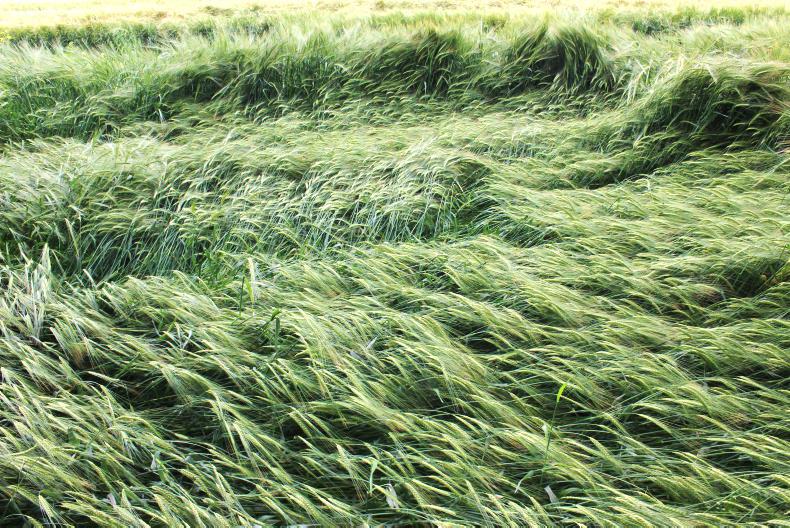
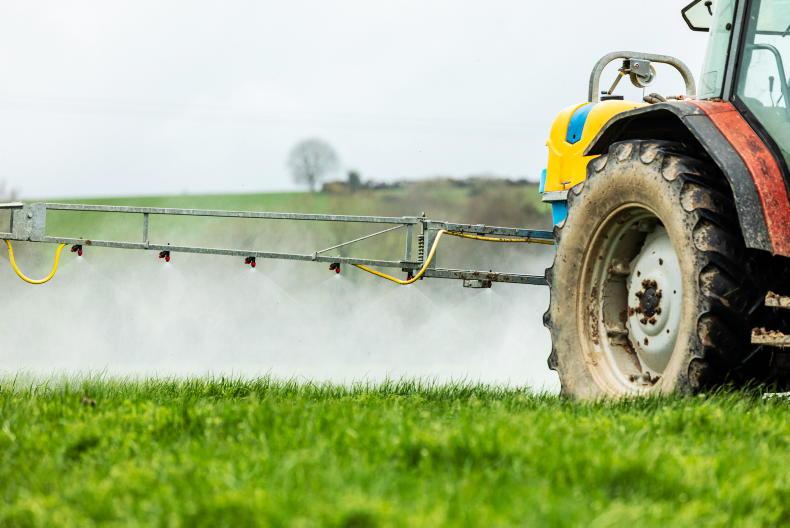
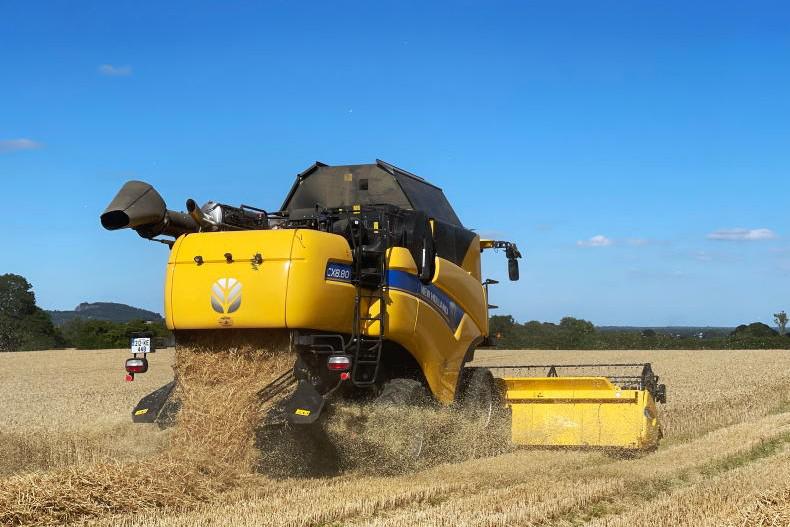
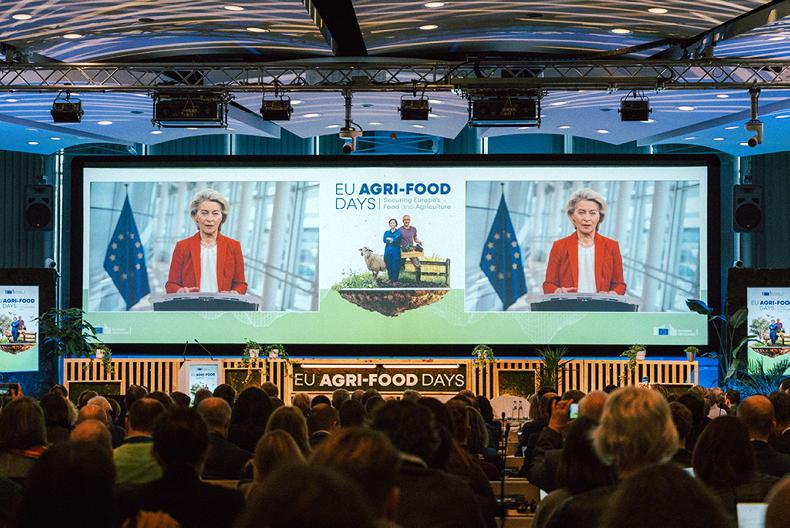
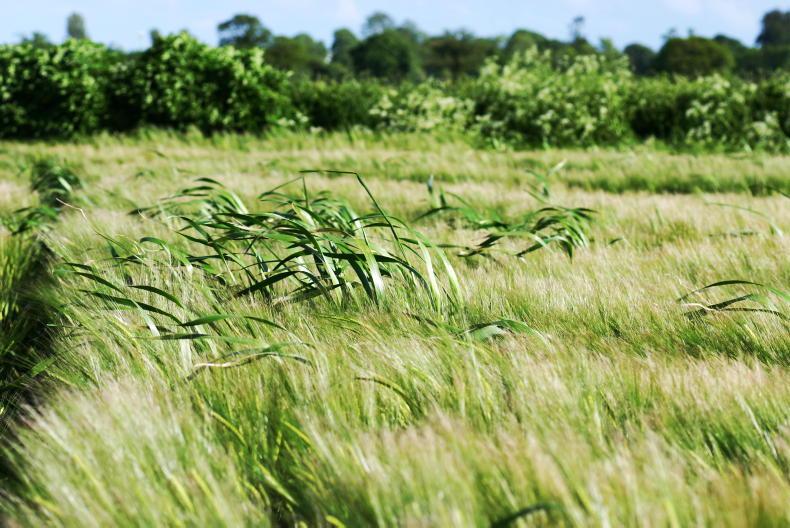
SHARING OPTIONS